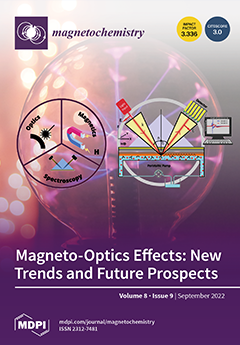An experimental study of the magnetocaloric effect in tetraaquabis(hydrogen maleato)nickel(II), [Ni(C
4H
3O
4)
2(H
2O)
4] powder sample is presented. The magnetocaloric properties of the studied sample were investigated using specific heat and magnetization measurements in
[...] Read more.
An experimental study of the magnetocaloric effect in tetraaquabis(hydrogen maleato)nickel(II), [Ni(C
4H
3O
4)
2(H
2O)
4] powder sample is presented. The magnetocaloric properties of the studied sample were investigated using specific heat and magnetization measurements in magnetic fields up to 9 T in the temperature range from 0.4 to 50 K. A large conventional magnetocaloric effect was found at a temperature of about 3.5 K, where −Δ
SM = 8.5 Jkg
−1K
−1 and 11.2 Jkg
−1K
−1 for a magnetic field of 5 T and 7 T, respectively. Assuming a substantial role of the crystal field, the temperature dependence of the magnetic specific heat in a zero magnetic field was compared with an
S = 1 model with single-ion anisotropy parameters
D and
E (axial and rhombic). The best agreement was found for the parameters
D/
kB = −7.82 K and
E/
kB = −2.15 K. On the other hand, the experimental temperature dependence of −Δ
SM shows higher values compared to the theoretical prediction for the mentioned model, indicating the presence of additional factors in the system, such as an exchange interaction between magnetic ions. The first exchange pathway can be realized through maleic rings between the nearest Ni(II) ions. The second exchange pathway can be realized through water molecules approximately along the
a crystallographic axis. Broken-symmetry DFT calculations performed using the computational package ORCA provided the values of ferromagnetic exchange interactions,
J1/
kB = 1.50 K and
J2/
kB = 1.44 K (using B3LYP functional). The presence of such ferromagnetic correlations in the studied system may explain the enhanced magnetocaloric effect compared with the model of an anisotropic spin-1 paramagnet.
Full article





